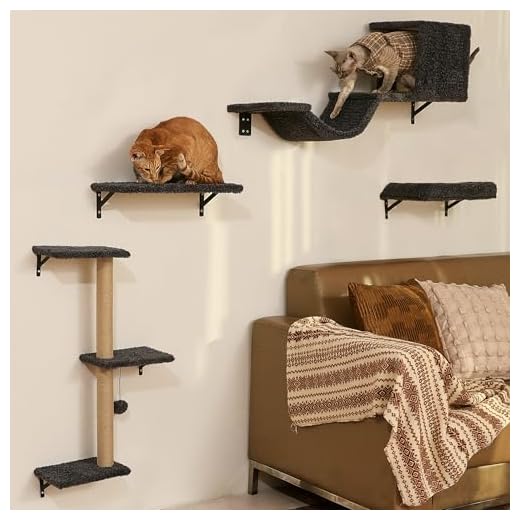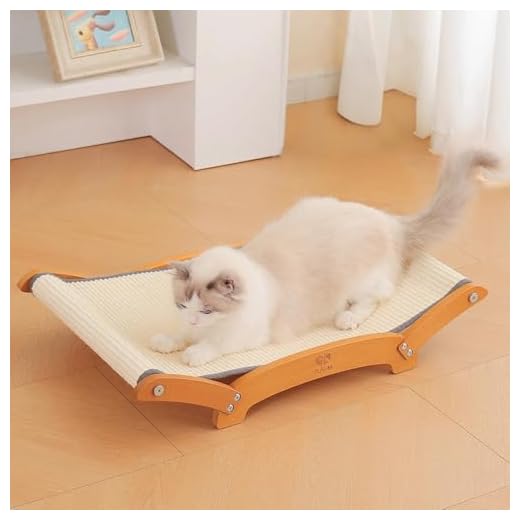

Provide a designated scratching post made from sturdy materials like sisal or cardboard. Place it in an area where I love to stretch out and scratch. This encourages me to use it instead of the couch.
Consider using furniture protectors or slipcovers. These can shield your beloved pieces while maintaining a stylish look. Choose options that are easy to clean, as I might still leave some fur behind.
Utilize citrus-scented sprays or double-sided tape on areas I tend to target. The scent deters me, while the sticky texture feels unpleasant under my paws. This simple trick can redirect my attention to more suitable scratching surfaces.
Regularly trim my claws to minimize damage. A quick clip every couple of weeks can help keep my nails in check. If you’re unsure, consult a vet or groomer for guidance.
Engage me with interactive toys and playtime. Keeping me entertained reduces the urge to scratch furniture. Rotate my toys to maintain interest and excitement during our play sessions.
Lastly, reward me with treats or praise when I choose the scratching post over the furniture. Positive reinforcement helps me understand what behavior is expected and appreciated.
Strategies for Protecting Your Home from My Paw-some Adventures
Providing scratching alternatives is key. Invest in sturdy scratching posts made of materials like sisal or cardboard. Place them near the areas I frequent, so I have a designated spot to satisfy my instincts. Make it more appealing by rubbing catnip on the posts or using treats as rewards.
Positive reinforcement works wonders. Whenever I use the scratching post instead of the couch, shower me with praise and a small treat. This helps me associate the post with something enjoyable, encouraging me to keep using it.
Furniture covers can serve as a temporary shield. Use slipcovers made of durable fabric that can withstand my playful antics while keeping your precious pieces protected. Look for materials that are easy to clean, as my adventures can get a bit messy.
Creating barriers is another tactic. Place double-sided tape on the furniture surfaces I tend to scratch. The sticky texture is unpleasant to my paws, making me think twice before targeting those areas again. Alternatively, you can use furniture protectors designed specifically for this purpose.
Redirecting my attention is effective too. Engage me with interactive toys or laser pointers to channel my energy elsewhere. When I’m busy playing, I’m less likely to focus on your beloved chairs or tables.
Regular nail trimming is crucial. Keeping my claws short reduces the damage I can do. You can easily learn to trim my nails or visit a vet or groomer for assistance if you’re unsure. This small effort can save your belongings from my enthusiastic scratches.
Lastly, consider pheromone diffusers. These products release calming scents that can reduce my urge to scratch out of stress or boredom. A serene environment can make a significant difference in my behavior.
Identifying Preferred Scratching Areas
Look for surfaces I naturally gravitate toward. Observe where I usually stretch or scratch. Common spots include carpets, couches, or even walls. Noticing these tendencies helps pinpoint areas that lure me in.
Common Preferences
Soft materials often attract my attention. I enjoy textures like fabric or sisal. If you have a favorite chair or a cozy blanket, these might be prime targets for my claws. Understanding these preferences allows you to redirect my focus effectively.
Creating Alternatives
Provide designated scratching posts or pads near the areas I prefer. Experiment with different textures and heights to find what excites me the most. By placing these alternatives strategically, you can encourage me to use them instead of your beloved furniture. For more tips on pet care, check out this link: do invisible fences shock dogs.
Choosing the Right Scratching Post
Opt for a sturdy scratching post that can withstand vigorous use. Look for materials like sisal and cardboard, as they are appealing to us furry friends. A stable base is crucial; a wobbly post won’t entice me to scratch.
Height and Design
- Choose a height that allows me to stretch fully. Ideally, it should be at least two feet tall.
- Consider vertical and horizontal options. Some of us prefer to scratch up high, while others like a flat surface.
- Design matters! Color and texture can attract my attention, so pick something visually appealing.
Location Matters
Place the post in an area where I frequently hang out. If it’s near my favorite lounging spot, I’ll be more likely to use it. If you’re unsure about the best placement, a best pet camera for cats can help you monitor my scratching habits.
Using Deterrents to Protect Furniture
Applying specific deterrents can effectively minimize unwanted scratching behaviors. Here are some strategies I’ve found helpful:
1. Citrus Scents
Many felines dislike citrus aromas. Using citrus-scented sprays or placing orange or lemon peels around the areas you want to protect can create an uninviting atmosphere.
2. Double-Sided Tape
Felines usually avoid sticky surfaces. Applying double-sided tape to the spots they favor can deter them from returning. This simple trick is often effective and easy to implement.
3. Commercial Deterrent Sprays
There are various sprays designed specifically to repel scratching. Look for products that are safe for pets and apply them to the targeted areas according to the instructions.
4. Physical Barriers
- Furniture covers: Use fabric or plastic covers to protect vulnerable pieces.
- Furniture shields: Transparent acrylic shields can act as an invisible barrier, preventing access to favored spots.
5. Noise Deterrents
Some products emit sounds when movement is detected. Placing these around your prized possessions can startle and discourage unwanted scratching.
6. Training with Positive Reinforcement
While using deterrents, reward alternative behaviors. When I scratched my post instead of the couch, I received treats. This encourages good habits.
Training with Positive Reinforcement
Whenever I scratch my designated post instead of the sofa, my human rewards me with a treat. This simple action encourages me to repeat the behavior. Consistency is key; each time I use the scratching post, I get a little snack or extra playtime, making it clear that this is the behavior they want to see.
Timing matters too. The treat should come immediately after I scratch the right surface. This helps me connect the dots between my actions and the rewards. I thrive on those tasty morsels and enjoy the attention, so I’m motivated to keep using my scratching area.
My human also uses a clicker to reinforce my good choices. The sound means I’ve done something right, followed by a delicious reward. This method creates a clear communication line between us, making training feel like a fun game.
Patience plays a significant role in this process. Sometimes I forget where I’m meant to scratch. My human gently redirects me back to the post without scolding. Instead, they offer a treat when I comply, reinforcing positive choices rather than punishing mistakes.
Incorporating different types of rewards can enhance the experience. Occasionally, my human surprises me with a new toy or extra cuddle time for using the scratching post. The variety keeps me engaged and eager to participate in this training routine.
Over time, I’ve developed a strong preference for my scratching post. With my human’s support, I’ve learned that there are enjoyable alternatives to scratching the furniture. It’s a win-win situation!
Regular Nail Trimming Techniques
Trimming nails every couple of weeks is a great way to manage those sharp points. I recommend using a pair of cat nail clippers or a human nail clipper designed for small nails. Make sure to have some treats on hand to reward your furry friend afterward!
Begin by getting your buddy comfortable with the process. Allow them to sniff the clippers and get used to the sound before you start. Hold one paw gently and press the pad to extend the nail. Be cautious to avoid the quick, which is the pink part inside the nail. Cut just the sharp tip to prevent any discomfort.
For a smoother experience, try trimming when your companion is relaxed, perhaps after a meal or a play session. If they squirm, take a break and try again later. Consistency helps them get used to this routine.
Additionally, consider using a scratching post regularly to keep those nails worn down naturally. It’s a win-win: they get to scratch, and you keep your furniture safe! Always celebrate their progress and make trimming a positive experience, so they look forward to it next time!
Covering Furniture with Protective Materials
Wrap surfaces with heavy-duty fabrics like canvas or denim. These materials resist wear and tear, providing a barrier against my playful paws. Consider using slipcovers to change the look of a couch while safeguarding it from scratches.
Sticky tape can be a simple yet effective option. Applying double-sided tape to areas I favor will deter my interest due to the unusual texture. Just remember to replace it regularly for maximum effectiveness.
For wooden surfaces, transparent plastic sheeting offers a protective layer while keeping the aesthetics intact. This solution is discreet and allows the natural beauty of the furniture to shine through.
Faux leather or vinyl can also be good choices. They are easy to clean and resistant to damage. If you’re looking for something decorative, opt for patterned fabric to maintain style while keeping surfaces safe.
Magnetic furniture protectors can be applied to edges and corners. I tend to target these areas, and having a protective barrier can minimize the damage. Make sure they’re securely attached to avoid any accidental slips.
Ultimately, experimenting with different coverings will help determine what works best for both of us. The goal is to balance aesthetics and functionality while keeping everything intact.
Creating a Stimulating Environment for Your Feline Friend
To keep boredom at bay, incorporate various interactive toys that require physical and mental engagement. Puzzle feeders, feather wands, and laser pointers are great for stimulating play. Rotate these toys regularly to maintain interest.
Designing a Play Zone
Establish a dedicated space for play, equipped with climbing shelves, soft surfaces, and cozy hideaways. This encourages exploration and exercise, making it less likely for me to seek out inappropriate scratching surfaces.
Incorporating Natural Elements
Integrate cat-friendly plants like catnip or wheatgrass into the environment. These not only provide entertainment but also promote healthy chewing habits. Ensure they are safe and non-toxic to create a worry-free space.
| Activity | Description |
|---|---|
| Interactive Toys | Engage in solo or partnered play with toys that stimulate mental and physical activity. |
| Climbing Structures | Provide vertical space for climbing and observation to satisfy natural instincts. |
| Chewable Plants | Include safe, edible plants for a fun and healthy chewing experience. |
By creating an enriching environment, I am less likely to target furniture for my scratching needs. This approach enhances my overall well-being and happiness.









